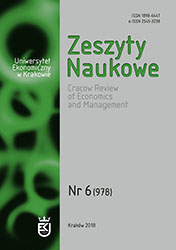Predicting Bankruptcy at Polish Companies: A Comparison of Selected Machine Learning and Deep Learning Algorithms
Predicting Bankruptcy at Polish Companies: A Comparison of Selected Machine Learning and Deep Learning Algorithms
Author(s): Joanna WyrobekSubject(s): Economy, Business Economy / Management, Micro-Economics, Socio-Economic Research
Published by: Wydawnictwo Uniwersytetu Ekonomicznego w Krakowie
Keywords: bankruptcy prediction; deep learning; machine learning; corporate finance
Summary/Abstract: Insolvency prediction is one of the crucial abilities in corporate finance and financial management. It is critical in accounts receivable management, capital budgeting decisions, financial analysis, capital structure management, going concern assessment and co-operation with other companies. The purpose of this paper is to compare the efficiency of selected deep learning and machine learning algorithms trained on a representative sample of Polish companies for the period 2008–2017. In particular, the paper tested the following popular machine learning algorithms: discriminant analysis (DA), logit (L), support vector machines (SVM), random forest (RF), gradient boosting decision trees (GB), neural network with one hidden layer (NN), convolutional neural network (CNN), and naïve Bayes (NB). The research hypotheses evaluated in the paper state that if one has access to a large sample of companies, the most accurate algorithm (first choice) in bankruptcy prediction will be gradient boosting decision trees (H1), random forest (H2) and neural networks (H3) (deep learning) algorithms. The initial hypotheses were formulated based on the practitioners’ opinions regarding the usefulness of various machine learning and artificial intelligence algorithms in bankruptcy prediction. As the results of the research suggest, both deep learning and machine learning algorithms proved to have very comparable efficiency. The new factor introduced in the paper was that the training of the models was carried out on a representative sample of companies (for years 2008–2013) and also the testing phase used a significant number of bankrupt and active companies (validation included a completely different set of companies than those used in the training phase: data were taken from a different time period, 2014–2017, and companies in both sets were also completely different).
Journal: Zeszyty Naukowe Uniwersytetu Ekonomicznego w Krakowie
- Issue Year: 978/2018
- Issue No: 6
- Page Range: 41-60
- Page Count: 20
- Language: English

